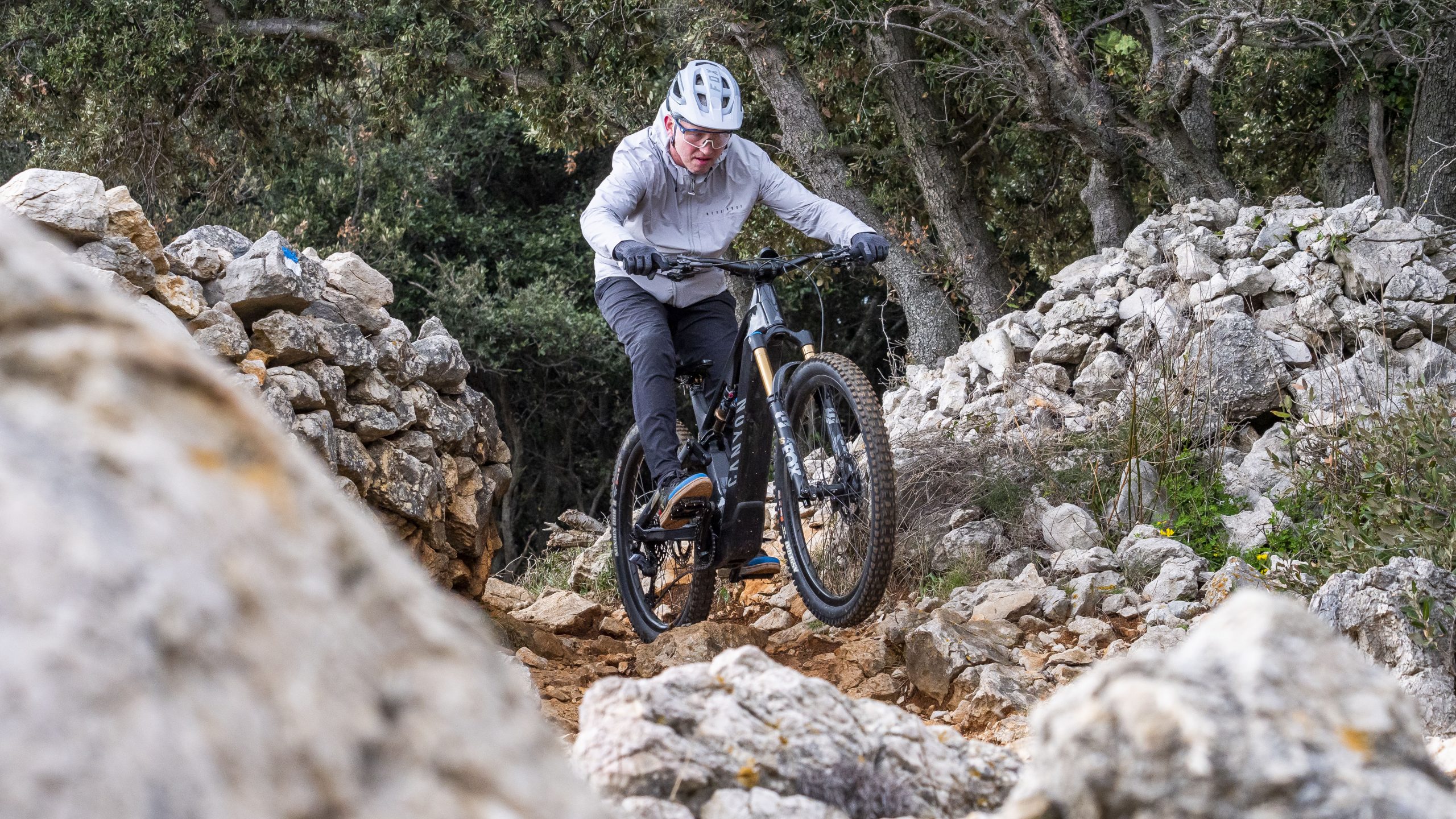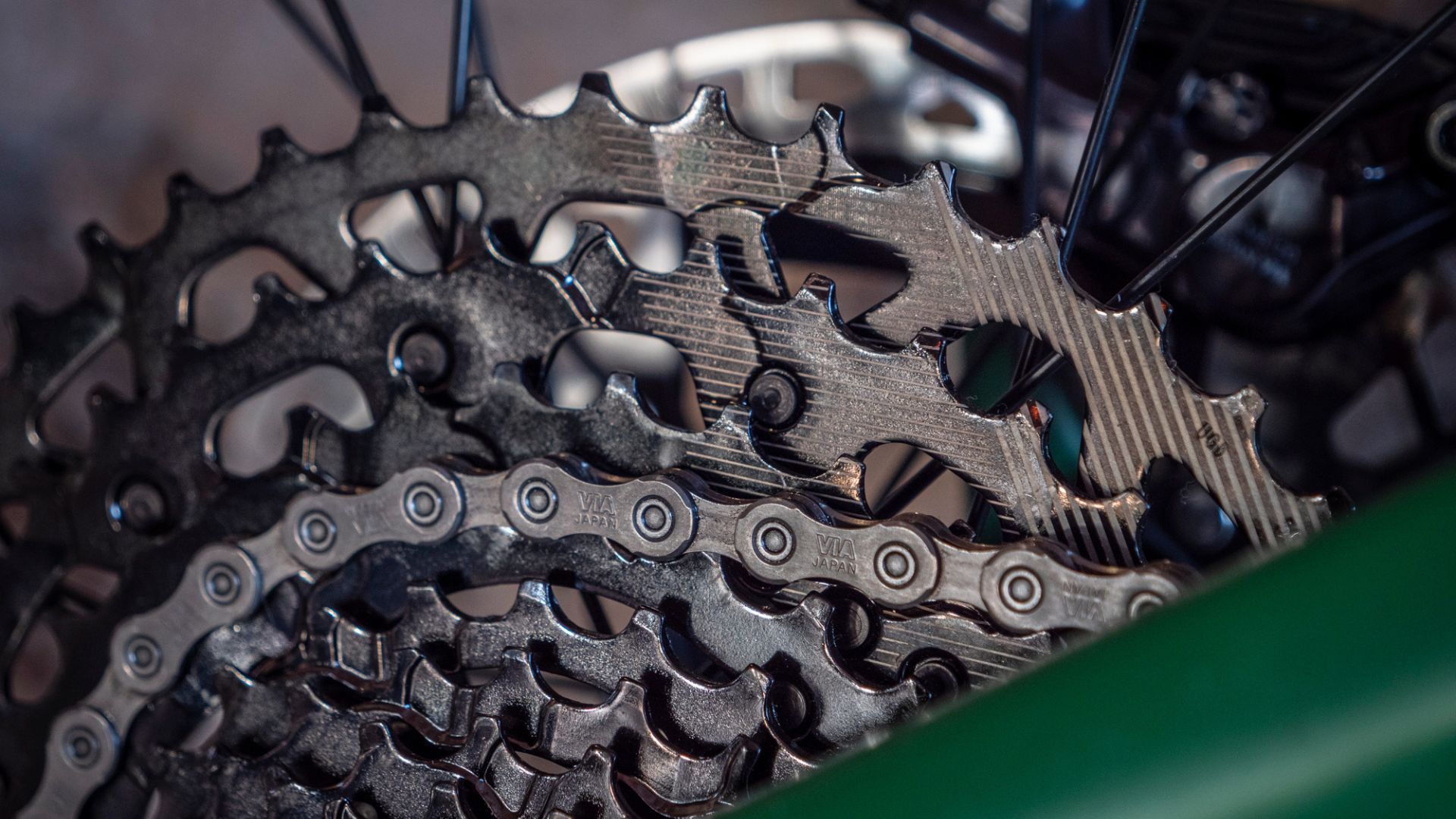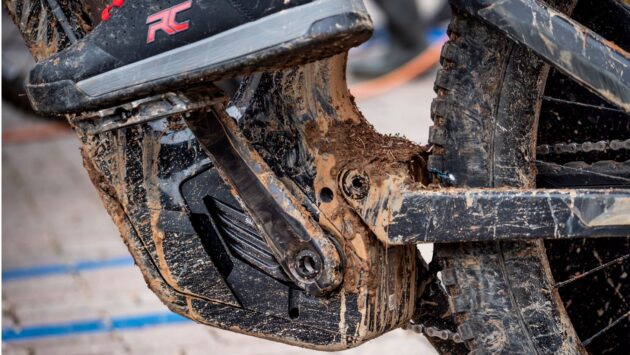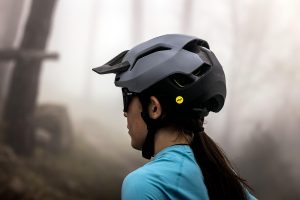The latest Shimano EP801 firmware update adds assistance, overrun and lots more customisation besides – it's a must-have for all Shimano motor owners.
Shimano’s EP801 firmware update is a must for e-bikers: it’s not always free, doesn’t match DJI’s power, but the overrun is perfect
In the race to build the best e-bike motor, Shimano has been falling behind. Bosch has its new Performance CX motor and it’s smarter than ever. Yamaha, Specialized, and now the DJI Avinox motors all pump out more power than the Shimano’s flagship EP801 drive unit, and arguably feel better to ride too.
That all changed this summer though, with a much needed EP801 firmware update that saw assistance rise to 400%, better overrun, and a faster response to your own pedalling inputs. More easily accessible power, in other words. On paper Shimano is back in the game, but how does EP801 feel in the real world? Is it as powerful as the latest Bosch Performance CX Gen 5? We put it to the test…
EP801 firmware need to know
- Now 400% assistance – access the full 600w of peak power without pressing as hard on the pedals
- More overrun, with up to 2m of power from the motor after you stop pedalling
- Power cut off at 25kph is now customisable, taper the power or have it disappear abruptly
- Update through bike shops or dealers only, with Shimano promising E-Tube update soon

Shimano EP801 dishes out 85Nm of torque and 600W of peak power
Who can get the EP801 update?
Anyone with an EP801 motor in their bike can get the latest update. Shimano said all bikes sold after the June update launch would automatically come with it installed, but it’s worth checking with your dealer this was done, as bikes often sit in warehouses for months without moving.
In theory the update to the latest version (5.3.2 in case you’re interested) is free, but at the moment it can only be done at a bike shop or dealer with the E-Tube Project Pro app. We’ve spoken to a few shops and they’re charging around £20 to plug it in and change the settings, simply because it takes around 30 minutes of labour.
Shimano’s plan is to make this available through the E-Tube app eventually, “in the version after version 5.3.2,” but by that time I expect everyone will have updated their motors anyway.
EP801 Race update: raw power
First up Shimano hasn’t actually increased the power of its motor, that would take more than just a firmware update. What it’s done is made the power of its motor more easily accessible, softer pedalling will now get you all the way to full power, with the motor now doing more of the work. Officially this assistance rate is now 400%.
And for the record, the update isn’t actually called EP801 Race, despite being heavily influenced by the enduro race teams that helped bring it to fruition. Really it’s just called Update to EP801 Version 5.3.2.
The next most important change is to the over-run, stop pedalling and Shimano’s motor will now carry you up to 2m (there are three settings), the idea being it’ll pull you up techie climbs that would otherwise have you off and pushing. Finally, the cut-off is now tunable, in the UK and EU the motor has to cut out at 25kph, but you can choose whether its an abrupt power stop or a gradual taper.

The YT Decoy is still relevant thanks to its great suspension and now access to a good power train
Performance
I tested the new EP801 update on YT’s Decoy, still one of the best electric mountain bikes of all time. It’s a bike I know really well, I’ve ridden every version since its launch in 2019 when it came with the old E8000 motor.
Riding in Boost mode, the updated EP801 gives the impression of delivering much more power. Of course that’s not really true, but the feeling is there all the same because you don’t have to spin your legs so fast to get all 600w of power. In this way it’s actually more akin to the now defunct E8000 system, which had much more of a digital feel to it – either you were getting full gas, or you were getting nothing.
The bike industry spent a long time after the likes of E8000 and Bosch’s third generation CX motor (they’re now up to five) trying to make e-bike motors feel akin to your normal pedalling power, where you require increasingly more effort and pedal speed to ride faster. Perhaps it’s realised e-bike riders don’t actually want this trait, they want power without effort.

The overrun will take you over some pretty chunky terrain, ideal when it’s too tight to pedal
Better even than more easily accessible power is the overrun, which Shimano says lasts for 2m on the maximum setting I went for. It’s not as powerful as Bosch’s CX Race overrun but in all honesty that’s probably a good thing because, dare I say it, CX Race can sometimes be too powerful in some situations, like climbing a steep switchback. Shimano has it bang on, EP801 now has just the right grunt to carry you up and over obstacles when there’s limited pedal clearance, and cancelling it simply requires you turn your pedals backwards half a crank.
My EP801 motor was updated at the YT Mill in Surrey, it took around 30 minutes and let me select from a bunch of settings like overrun and assistance. I was also able to choose when the power would cut out, I went for a harsh cutout at 25kph, the logic being I’d get the most power from the motor that way… and hang the consequences. In hindsight I’d tone that down because the cutoff is too abrupt now, and while it’s nothing like as on-off as E8000 it’s not ideal having the motor go dead. Shimano needs to prioritise making this a feature in the E-Tube app because it’s hard to know exactly what you want without trying first.
Is Shimano EP801 now faster than Bosch CX?
Nope, Bosch still has the edge, I benchmarked EP801 against the Bosch CX Gen 4 motor and found it around three seconds slower on a 50 second climb. On flatter terrain the Shimano is an equal match for the Bosch but the steeper it gets the less power it seems to generates. It’s not getting its pants pulled down anymore like it used to, and I no longer think it’s a deal breaker, but the gap still remains. It’s also more important to keep the cadence high on EP801 and that diesel-like torque of the CX isn’t quite there still.
Freeshift updated too
Autoshift is Shimano’s tech that’ll automatically change gear when it senses you need it. The YT Decoy I used didn’t have this feature, instead it uses Freeshift – you choose the gear and the motor will automatically turn the motor over and push the chain up or down the cassette, all without you having to pedal. Shimano has updated this feature now, speeding up the shifting.
In the past we’ve found Freeshift too slow to shift to easier gears when you’re slowing down, and it’s been hugely successful. I found EP801 put me in just the right gear on almost all occasions. Where it still isn’t fast enough is on abrupt little rises on faster downhill sections. Here it still didn’t shift fast enough, probably because I was shifting down even when the bike wasn’t decelerating.
Shimano EP801 AutoShift review
For a lot of riders, e-bikes have made trails more accessible, and climbs a lot easier, but imagine if your e-bike did other things for you, like changing gear. That sounds like a pipe dream, but it’s exactly what Shimano’s updated motors deliver. The new EP801 (and cheaper EP60) has a new Auto Shift function, in combination with the electronic XT Di2 drivetrain, that allows the bike to change gear automatically.
Need to know
- Updated EP8 motor gets new functionality and improved sealing
- No increase in power or torque with EP801
- Auto Shift combines motor and Di2 electronic drivetrain to fully control gear changing
- Uses new 11-speed Linkglide chain and cassette, which are cheaper and more durable
 This is possible because the chainring on an eBike is independent of the crank spindle, so the motor can spin the chainring and change the gear regardless of whether you’re using your legs to spin the cranks. And yes, it is totally bonkers to look down and see the chainring rotating and hear the bike change gear when you’re just coasting downhill.
This is possible because the chainring on an eBike is independent of the crank spindle, so the motor can spin the chainring and change the gear regardless of whether you’re using your legs to spin the cranks. And yes, it is totally bonkers to look down and see the chainring rotating and hear the bike change gear when you’re just coasting downhill.
Smart Algorithm
Essentially there are two parts to Auto Shift – a smart algorithm that monitors things like cadence, torque, and speed, and the new 11-speed Linkglide cassette. To begin with you set two parameters using Shimano’s e-Tube app, the first being the Shift Timing, which is tunable between 50-100rpm. If you like to spin more when you ride you can set this at a higher RPM and the motor will change accordingly. You also set the Climb Response, which equates to the amount of force you put through the pedals.

Like most things, Shimano does recommend a ballpark setting in the app (72rpm with a climb response of 4) but there are over eight levels to pick from in the advanced menu. Users can also set two profiles – for example, one for road and the other for dirt, which can be toggled via a small button on the new DI2 shifter. And that’s not all – you can also set a start gear, so when you slow to a stop the bike will sense it and automatically shift into this default gear for when you want to pull away again.
New Linkglide Cassette
To ensure the shifts are as clean and as smooth as possible, Shimano has created a new 11-speed Linkglide cassette specifically for e-bikes running Autoshift. The first question we asked is why 11-speed? Apparently it has nothing to do with the idea that e-bikes need fewer gears, but more to do with packaging.

To create the smoother shift, Shimano has increased the height and width of the teeth, and that means the overall dimension of the 11-speed Linkglide cassette is roughly the same as a 12-speed Hyperglide cassette. There’s also a compatibility issue as Shimano wanted the Linkglide cassette to fit on a standard splined cassette body rather than Microspline.
Shimano has also removed a number of shift gates from several of the cassette sprockets, which means the cassette isn’t as quick to shift as a Hyperglide cassette, but it’s a lot smoother, and Shimano says it is over 300% more durable. The 11-speed Linkglide cassette is available in 11-50t. There is a slight increase in weight and it does require you to use a dedicated 11-speed chain, but it is significantly cheaper than 12-speed options, which is to be applauded.

Shimano EP801 motor
Although fundamentally similar to EP8, there have been a couple of small updates to the new EP801 motor. Shimano has improved the quality of the sealing, but it hasn’t eliminated that infamous EP8 rattle. This is because EP8 and EP801 use a clutch mechanism, which disengages fully from the internal drive.
It’s also one of the reasons the Shimano motor has less drag when you hit the speed limiter, so you don’t feel like you’re pedalling through treacle.
There’s also improved heat management and a couple of additional connection ports for powering accessories. Weight seems to have crept up by 100g, too. Shimano’s staff wouldn’t reveal what the peak power output is, but we found it listed on the Shimano EU website at 600w. Like the EP8, it still packs 85Nm of torque and remains one of the most compact full power motors on the market.
Manual Operation
Shimano recognises Auto Shift is not for everyone, or may not be something you want to use all of the time, which is why there’s a full manual option. You can also access manual shifts while in Auto Shift mode for those times when you can see the terrain ahead changing and need to override the AI.

The new motor also has a Free shift function, which literally means you can shift and change gear without actually pedalling. While testing the system it did occur to us that a really cool feature would be to have a lube mode, where the motor actually rotates the chain, so you could lube the chain without having to lift the rear wheel off the ground.
How does it ride?
We actually think experienced riders are going to take longer to get used to the system because years of riding have programmed our brains to reduce power through the drivetrain when shifting. With Auto Shift, the chain and pedals are decoupled during the shift phase, so that tension is greatly reduced. It’s not totally eliminated, because there are times when you are pedalling and the bike is trying to shift at the same time. We’re unsure what has priority in these situations, but there are times when it can feel a little clunky.

Shimano EP801 motor and Auto Shift
There were also specific situations where the bike would shift into a harder gear and we didn’t really want it to. On one of the test trails, there was a short, steep incline and the usual technique, even on an e-bike, is to put in a couple of revs to boost up the bank.
However, Auto Shift detected this increase in cadence and changed up, which left us in too hard a gear. It did shift to an easier gear again, but there was a lot going on in a short period of time. Also, rolling over a crest into a descent, the motor would often take a split-second longer to shift up – it’s almost like you are waiting for the bike to catch up. However, in both of these situations, you can override the AI and shift manually.

Where Auto Shift really came into its own was on rolling terrain. The sort of trail where you’re putting in multiple shifts and have to be quite mindful of when and where you have room to sneak in a crank revolution. With Auto Shift the bike does all that for you, regardless of whether you have the time or not. And the motor doesn’t hold back, if it thinks you’re struggling, or starting to spin out, it will change gear. The actual speed of the shift is at a constant rate, regardless of whether you’re climbing or descending, but according to Shimano it has to be, otherwise the bike would actually be driving you forward.
Generally, we found Auto Shift works best if you’re slightly more aggressive when tackling steep ascents, because the bike will sense when you’re starting to slow and change into an easier gear. The traction was pretty consistent – we couldn’t detect much wheelspin.
There are some obvious questions with Auto Shift. Does it herald the arrival of a fully automated mountain bike? Are we dumbing down riding, so that we become more of a passenger and less of a pilot? Right now, it’s hard to say, because we’ve only put less than 10-hours on the new EP801, but beginners are obviously going to benefit from Auto Shift the most because it eliminates one of the most complicated parts of riding – when to change gear. Which leaves more mental capacity free to focus on braking, steering, pedalling and body position.

But there are advantages for the experienced rider too, because how many times have you not had time to change gear, or got bogged down, even on an e-bike? If you brake hard into a tight turn, stall on a climb, or even stop to open a gate, Auto Shift is going to put you in the right gear when you get going again.
The other unknown is how the system behaves in typical UK conditions. In mud and slop, you tend to ride a harder gear to eliminate wheel spin, but that might just be a case of setting it up with a lower cadence.
- Best mountain bike groupsets and drive trains
- Essential e-bike handling skills: make the most of your electric mountain bike
- Riders on the Storm: Llandegla’s road to recovery
Verdict
Shimano is back in the game with EP801, it’s gone from being one of the least desirable motors on the market to one of the best. OK, so Bosch CX still beats it on grunt but the Shimano power unit is easier to control and less likely to fire you off the trail into the bushes. I like its blend of subtle power and control, and it’s quieter now too. I wouldn’t seek out an bike with EP801… but now I wouldn't be put off it either.
















